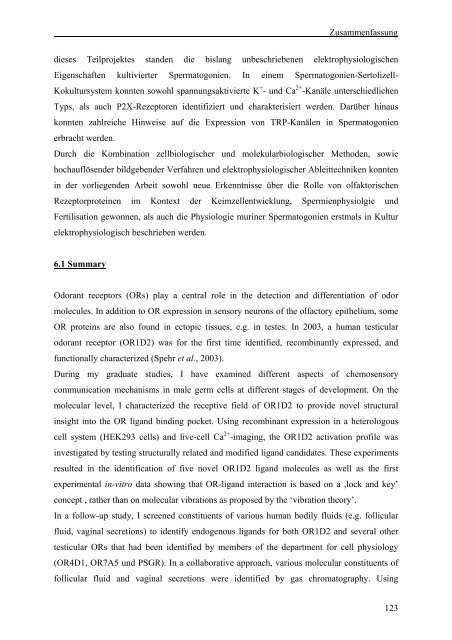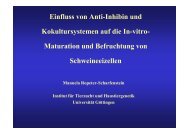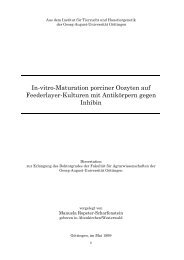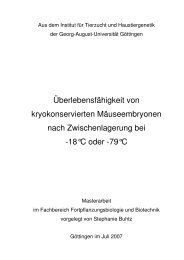Identifikation und funktionale Charakterisierung - Logo Dragon-Ivf ...
Identifikation und funktionale Charakterisierung - Logo Dragon-Ivf ...
Identifikation und funktionale Charakterisierung - Logo Dragon-Ivf ...
Erfolgreiche ePaper selbst erstellen
Machen Sie aus Ihren PDF Publikationen ein blätterbares Flipbook mit unserer einzigartigen Google optimierten e-Paper Software.
Zusammenfassung<br />
dieses Teilprojektes standen die bislang unbeschriebenen elektrophysiologischen<br />
Eigenschaften kultivierter Spermatogonien. In einem Spermatogonien-Sertolizell-<br />
Kokultursystem konnten sowohl spannungsaktivierte K + - <strong>und</strong> Ca 2+ -Kanäle unterschiedlichen<br />
Typs, als auch P2X-Rezeptoren identifiziert <strong>und</strong> charakterisiert werden. Darüber hinaus<br />
konnten zahlreiche Hinweise auf die Expression von TRP-Kanälen in Spermatogonien<br />
erbracht werden.<br />
Durch die Kombination zellbiologischer <strong>und</strong> molekularbiologischer Methoden, sowie<br />
hochauflösender bildgebender Verfahren <strong>und</strong> elektrophysiologischer Ableittechniken konnten<br />
in der vorliegenden Arbeit sowohl neue Erkenntnisse über die Rolle von olfaktorischen<br />
Rezeptorproteinen im Kontext der Keimzellentwicklung, Spermienphysiolgie <strong>und</strong><br />
Fertilisation gewonnen, als auch die Physiologie muriner Spermatogonien erstmals in Kultur<br />
elektrophysiologisch beschrieben werden.<br />
6.1 Summary<br />
Odorant receptors (ORs) play a central role in the detection and differentiation of odor<br />
molecules. In addition to OR expression in sensory neurons of the olfactory epithelium, some<br />
OR proteins are also fo<strong>und</strong> in ectopic tissues, e.g. in testes. In 2003, a human testicular<br />
odorant receptor (OR1D2) was for the first time identified, recombinantly expressed, and<br />
functionally characterized (Spehr et al., 2003).<br />
During my graduate studies, I have examined different aspects of chemosensory<br />
communication mechanisms in male germ cells at different stages of development. On the<br />
molecular level, I characterized the receptive field of OR1D2 to provide novel structural<br />
insight into the OR ligand binding pocket. Using recombinant expression in a heterologous<br />
cell system (HEK293 cells) and live-cell Ca 2+ -imaging, the OR1D2 activation profile was<br />
investigated by testing structurally related and modified ligand candidates. These experiments<br />
resulted in the identification of five novel OR1D2 ligand molecules as well as the first<br />
experimental in-vitro data showing that OR-ligand interaction is based on a ,lock and key’<br />
concept , rather than on molecular vibrations as proposed by the ‘vibration theory’.<br />
In a follow-up study, I screened constituents of various human bodily fluids (e.g. follicular<br />
fluid, vaginal secretions) to identify endogenous ligands for both OR1D2 and several other<br />
testicular ORs that had been identified by members of the department for cell physiology<br />
(OR4D1, OR7A5 <strong>und</strong> PSGR). In a collaborative approach, various molecular constituents of<br />
follicular fluid and vaginal secretions were identified by gas chromatography. Using<br />
123





